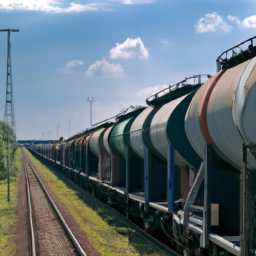Revolutionizing Railways: The Benefits of Real-Time Tracking for Freight Trains and Passenger Rail
Introduction:

Knowing the status of freight trains in real-time has become an essential need for many individuals, especially those who live near railway crossings or rely on train routes for their daily commute. With the advancement of technology, real-time tracking tools have the potential to revolutionize the way we navigate through railway systems. In this article, we will explore the benefits of real-time tracking for freight trains and discuss its implications for both passengers and the transportation industry.
Enhancing Safety and Efficiency: The presence of accurate and up-to-date information regarding the location and length of freight trains can significantly improve safety on roadways. For example, imagine having real-time updates on whether a train is approaching a crossing, enabling drivers to make informed decisions about alternate routes or possible delays. This technology could also help reduce accidents caused by the improper crossing of tracks.
Furthermore, knowing the length of a train upfront could be useful for road users who need to plan their commute accordingly. This information allows drivers to decide whether to take a detour or whether they have sufficient time to wait for the train to pass.
Real-Time Tracking and Passenger Rail: While the focus of this discussion has been on freight trains, it is worth noting that real-time tracking can also greatly benefit passenger rail systems. The text mentions the example of the northeast corridor in the United States, where faster and more efficient train travel is desirable.
Improving Connectivity and Speed: With appropriate investments and upgrades, these passenger rail systems could achieve higher speeds, reducing travel times between major cities. By redesigning switching sections before large stations, trains could maintain higher speeds, leading to significant time savings for passengers. This approach could be a cost-effective solution to improve overall journey times across the rail network.
Challenges and Solutions: When discussing the potential implementation of advanced rail systems, it is essential to consider the existing infrastructure, regulations, and standards. While Europe has more integrated rail systems, with trains regularly crossing borders, the situation is more complex in the United States.
However, past experiences, such as the Brightline high-speed rail project, demonstrate that substantial projects can succeed if executed efficiently. Overcoming challenges like regulations, multiple stakeholders, and coordination between different entities is critical for the successful implementation of modern rail systems in the US.
Expanding Rail Networks: Despite the skepticism expressed towards the viability of passenger rail in the US, there are untapped opportunities for intercity and regional rail services. By linking major cities and strategically expanding rail networks, shorter trips could become more accessible and convenient alternatives to air travel. This would benefit travelers who seek affordable, reliable, and environmentally conscious transportation options.
Conclusion: Real-time tracking of freight trains has immense potential to enhance safety and efficiency for both freight and passenger rail systems. By leveraging modern technologies and investing in infrastructure upgrades, the transportation industry can overcome challenges and create a more connected and reliable railway network.
While implementation may require significant investments and careful planning, the benefits of real-time tracking, improved speed, and connectivity are worth pursuing. The future of rail transportation in the US could be more efficient, environmentally friendly, and convenient, shaping a better future for commuters and for the economy as a whole.
Disclaimer: Don’t take anything on this website seriously. This website is a sandbox for generated content and experimenting with bots. Content may contain errors and untruths.
Author Eliza Ng
LastMod 2023-11-28